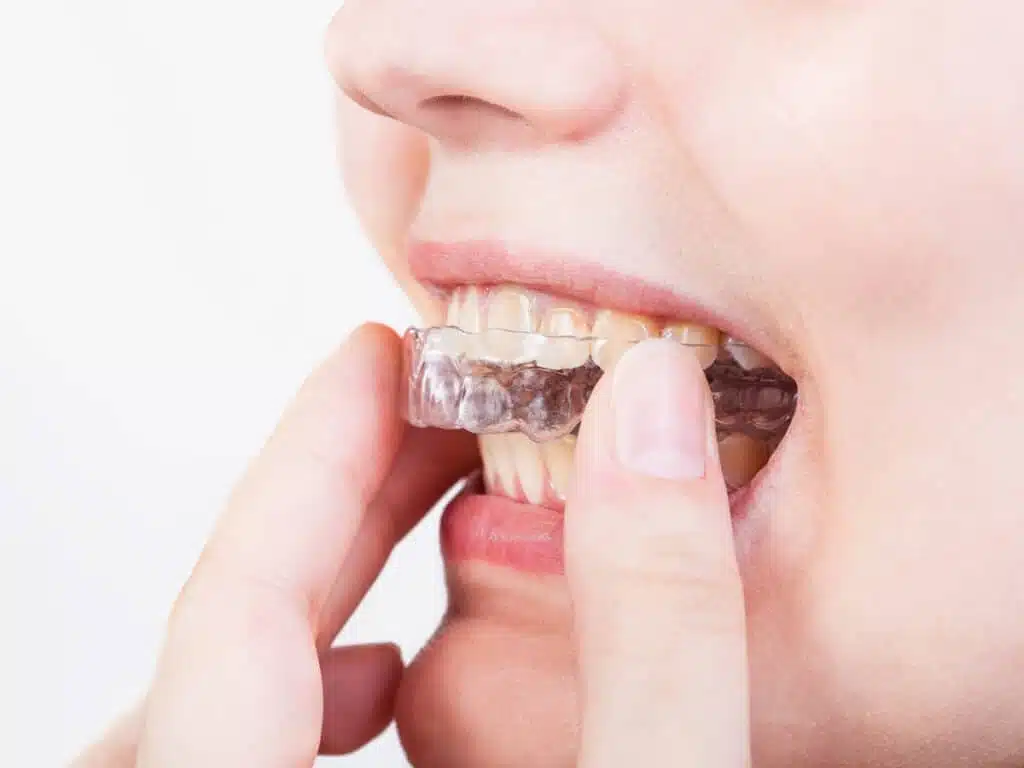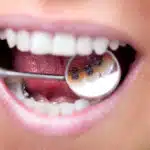Invisalign after fixed braces: Is it possible to switch to invisible aligners after or during a classic tooth correction?
Nowadays, the correction of malocclusions is easier and more diverse than ever before. Two popular options are traditional fixed braces and the innovative Invisalign system.
While fixed braces are made of metal and are permanently attached to the teeth, Invisalign consists of transparent plastic trays that are removable.
But what happens if someone is already wearing fixed braces and wants to switch to Invisalign?
Can I switch from fixed braces to Invisalign? In this article we will discuss this issue in depth and highlight all the important aspects.
| Get 150 € discount on your dental correction! |

Book a consultation appointment now at a nearby DrSmile partner practice and find out if teeth straightening with aligners is right for you.
The appointment is completely non-binding and does not involve any costs.
With the code “THATSMILE150” you will receive 150 € discount on the treatment.
Differences between fixed braces and Invisalign
Before we look at switching from fixed braces to Invisalign, it’s important to understand the differences between the two treatments.
Here are some key differences:
Materials
Fixed braces consist of metal brackets that are attached to the teeth and a wire that connects the brackets together.
Invisalign, on the other hand, uses transparent plastic trays that are custom-made for the patient.
Visibility
The visible presence of fixed braces can be unappealing to some people, especially adults who want a more discreet solution.
Invisalign, on the other hand, are transparent and barely noticeable, making them a more popular option.

Comfort
Fixed braces can be uncomfortable at first, as the mouth has to get used to the presence of the metal brackets.
Invisalign are smooth and comfortable to wear, without the risk of injury or irritation to the mouth.
Cleaning and care
With fixed braces, cleaning the teeth is often difficult because the brackets and wires are in the way.
Invisalign can be removed, allowing for thorough dental care and cleaning.
Treatment duration
The duration of treatment with fixed braces can be several years, depending on the severity of the malocclusion.
Invisalign are usually faster, but the exact duration depends on the individual situation.
Invisalign after fixed braces: Can I just switch?
Switching from fixed braces to Invisalign is possible in principle, but this must be carefully considered.
It is important to evaluate the current situation and have a professional consultation with an experienced orthodontist.
The orthodontist will assess the progress of the current treatment, evaluate the misalignment of the teeth and determine the suitability for Invisalign.
The switching process requires certain preparations. Some additional measures may need to be taken before the change to ensure that the teeth and jaw are prepared for the change.
This may include the use of rubbers or other aids to align the teeth.
| Get 150 € discount on your dental correction! |

Book a consultation appointment now at a nearby DrSmile partner practice and find out if teeth straightening with aligners is right for you.
The appointment is completely non-binding and does not involve any costs.
With the code “THATSMILE150” you will receive 150 € discount on the treatment.
Invisalign after fixed braces: Here’s how the transition goes
Switching from fixed braces to Invisalign involves several steps:
- Removal of fixed braces: First, the metal brackets and the wire of the fixed braces are removed. This process is usually painless, but there may be a temporary feeling of pressure.
- Impressions and digital scans: After the fixed braces are removed, impressions are taken of the teeth or digital scans are taken. These serve as the basis for the fabrication of the individual Invisalign.
- Fitting the Invisalign: The impressions or scans are sent to a lab where the custom-made Invisalign are made. These are then returned to the orthodontist.
- Insertion of the first splint: As soon as the Invisalign are ready, the first splint is inserted. The orthodontist will make sure it fits well and make any necessary adjustments.
- Course of treatment with Invisalign: Invisalign involves regular wearing of the splints, replacing them with a new one every one to two weeks. The progress of the treatment is regularly monitored and adjusted to achieve the desired results.
Advantages of switching from fixed braces to Invisalign
Switching from fixed braces to Invisalign offers several advantages:
- Aesthetics and discretion: Invisalign are virtually invisible, making them a more aesthetically pleasing option.
- Convenience and comfort: Invisalign are smooth and comfortable to wear, without the risk of injury or irritation.
- Better oral hygiene: The ability to remove the splints allows for more thorough dental hygiene and cleaning.
- No restrictions on eating: Unlike fixed braces, there are no restrictions on eating with Invisalign.
- Improved quality of life: Switching to Invisalign can increase self-confidence and have a positive impact on quality of life.
DrSmile is a cheaper alternative to Invisalign
Do you only need an esthetic correction of the front teeth or do you only have a slight to moderate malocclusion?
Then we clearly recommend cheaper providers like DrSmile. Because the company offers a very good price-performance ratio and communicates its prices transparently.
Only high-quality materials and state-of-the-art technologies are used in the production “made in Germany & USA”.
Through the app, the course of treatment is regularly monitored and kept in view by dentists and orthodontists. Last but not least, DrSmile offers a satisfaction promise.
In this article, we compare the two providers in more detail: DrSmile vs. Invisalign. You can book a free and non-binding consultation appointment here.
Conclusion on Invisalign after fixed braces
Switching from fixed braces to Invisalign is possible and offers several advantages.
However, a thorough evaluation and consultation with an orthodontist are essential to determine suitability for the change.
Invisalign provides an aesthetically pleasing and comfortable treatment with numerous benefits for oral hygiene and quality of life.
If you are interested in switching from fixed braces to Invisalign, you should contact an experienced orthodontist for more information and to begin the process.
| Get 150 € discount on your dental correction! |

Book a consultation appointment now at a nearby DrSmile partner practice and find out if teeth straightening with aligners is right for you.
The appointment is completely non-binding and does not involve any costs.
With the code “THATSMILE150” you will receive 150 € discount on the treatment.
FAQs about Invisalign after fixed braces
At this point we will answer some frequently asked questions about the topicInvisalign after fixed braces”.
Can anyone switch from fixed braces to Invisalign?
Yes, in most cases, switching is possible. However, a professional evaluation and consultation with an orthodontist is required to determine suitability. Incidentally, Invisalign Teen is also suitable for teenagers under the age of 18.
How long does Invisalign treatment take compared to fixed braces?
The duration of treatment with Invisalign is usually shorter than with fixed braces, but the exact duration depends on the individual situation. Invisalign the case of very slight malocclusions, the particularly time-efficient Invisalign i7 method can be used.
Is Invisalign as effective as fixed braces?
Invisalign is an effective method of correcting misaligned teeth. However, the effectiveness depends on the type and severity of the deformity. In some cases, fixed braces may be a better option.
Is the cost of Invisalign higher than fixed braces?
The cost of Invisalign may be slightly higher than fixed braces, depending on the case. The exact cost should be discussed with the orthodontist.
What happens if I lose my trays during Invisalign?
If a splint is lost, the orthodontist should be contacted. Usually, lost splints can be replaced to continue the course of treatment.



Leave a Reply